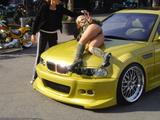 The E92 model is the fourth generation of the M3, a car that first arrived in 1986. Back then it had a four-cylinder engine with around 200bhp. The new car doubles that with a V8 and 414bhp, but the basic ingredients remain the same: rear-wheel drive, a limited slip differential and a motorsport-inspired engine that revs to a whopping 8400rpm.
The E92 model is the fourth generation of the M3, a car that first arrived in 1986. Back then it had a four-cylinder engine with around 200bhp. The new car doubles that with a V8 and 414bhp, but the basic ingredients remain the same: rear-wheel drive, a limited slip differential and a motorsport-inspired engine that revs to a whopping 8400rpm.
When it goes on sale in the UK in early September, the M3 will cost £50,625 and will, at first, be available only as a two-door coupe. A convertible and four-door saloon are expected to follow next year, while a Touring wagon is under evalution but less likely to make production. All in all, the broadened range will help break (hopes BMW) the 100,000-unit barrier for the first time. The last M3 – 2000’s six-cylinder E46 – is a tough act to follow, however.
So M3 grows up, gets two more cylinders. Didn’t that end in disaster last time around?
Not disaster, no, but the purists weren’t pleased when the second-generation E36 arrived in 1992. But it was a brave move and something that transformed the M3 from a niche motorsport product to the international icon it is today.
The last car’s 3.2-litre six-cylinder wouldn’t meet forthcoming emissions regulations and rivals – including Audi with the RS4 and Mercedes with the C63 AMG – upped the game with V8s, leaving Munich with little option but to match them. The American market has been a big consideration too, 50 percent of all cars expected to go Stateside.
This, then, is the first time the M3 has changed significantly since 1992.
Just like back in 1992, the E92 will leave the hardcore craving more – there’s definitely room for a hardcore CSL-style edition, more of which later. And the V8 does significantly alter the M3’s character. Where before a creamy straight-six throatiness was followed by the trademark metallic rasp towards peak rpms, now a nice woofly warble under lighter throttle loads precedes a hard-edged – if more muted – charge for the redline. The spine-tingling zinginess of the E46 car is gone, replaced by a more mature, if still exhilarating, progression.


 Unsurprisingly, the quest for a high-revving engine has left a hole in the torque low down, so you need to stir that six-speed manual (the only option for now, though SMG will follow) to really get moving. The ’box is carried over from the E46 and obviously shares its characteristics: direct but a little arthritic.
Unsurprisingly, the quest for a high-revving engine has left a hole in the torque low down, so you need to stir that six-speed manual (the only option for now, though SMG will follow) to really get moving. The ’box is carried over from the E46 and obviously shares its characteristics: direct but a little arthritic.
Impressively, the new larger engine is 15kg lighter than the six-pot in the E46 thanks to clever lightweight tech. But, like the rest of the E92 range, turn-in still feels a bit dumbed down and numb. Understeer was never an issue in the last car – it just dived into a corner with razor-sharp precision. The new M3 has a little more roll on turn-in, and you can feel the loads building on the front tyre as forces increase.
Strangely, the suspension might not be entirely to blame; BMW commissioned Michelin to develop tyres specially for the M3 that feature a compound to induce mild understeer in more extreme circumstances. Quite why this is necessary we’re not sure. BMW has already fitted stability control, and the steering wheel-activated M mode allows a little oversteer while still retaining a safety net. We’d be intrigued to drive a car on regular rubber.
Less focused handling does improve the ride quality significantly with the M3 soaking up bumps much better than its predecessor ever did. There are also three (optional) cockpit-adjustable suspension settings, so you can stiffen the dampers and reduce body roll for track work. However, BMW supplied all the test cars on 18in alloys, so we’re unable to report on the lower profile – and doubtless hugely popular – 19in option.
The steering is light and impressively linear but lacks the meaty heft of its big brother, the M5, or the finely detailed feedback of a 911.
Brakes have long been an M3 weakness, but the single caliper items fitted to the test car coped admirably with high-speed runs on the tortuous Spanish mountain roads that formed our road route. They did squeak embarrassingly however, as they did on several test cars. And whether they’ll last on track we’re yet to find out – we were limited to one lap before coming back through the pits to queue for another run, allowing the stoppers to cool.
Once you’re sideways the E92 is an extremely easy, progressive car to hold in a drift (see p1), but it takes a little more determination to get it there in the first place thanks to that softer, woollier front end.
The M differential once again makes an appearance – a key ingredient in making the last car so easy to slide – offering progressive power transfer from a spinning wheel to one with more grip until, under extreme duress, the diff locks completely and both tyres spin with equal ferocity.
You’ll feel it on the road, making tight hairpins a pleasure to exit on the power rather than the one-wheel bonfire that is the BMW 335i. All that extra power – nearly 80bhp up from last time – does mean the traction control intervenes more frequently, but it’s rarely intrusive and keen drivers can reduce its role with a press of the M button.
With high quality plastics and leather, intuitively laid out controls (iDrive will always have its detractors, but for the most part we like it) and sound ergonomics, the new M3 is a good place to be. In fact, it’s simply an organic evolution of the old model, something that will appeal to those turned off by the M5 and M6’s hyper-tech interiors and illuminated gearknobs.



 The seats (leather and cloth as standard, or optional full leather) are geared for comfort and, though perfect in most conditions, would benefit from M5-sytle active bolsters to better grip lunatics on a mission. As before, rear legroom is nothing more than adequate so six footers sitting behind six footers will feel cramped.
The seats (leather and cloth as standard, or optional full leather) are geared for comfort and, though perfect in most conditions, would benefit from M5-sytle active bolsters to better grip lunatics on a mission. As before, rear legroom is nothing more than adequate so six footers sitting behind six footers will feel cramped.
The M3 has grown up and lost a little of the E46’s edge to the more weight/more power vicious circle. But BMW has no doubt judged the market perfectly. The M3 is now a genuine volume seller and, last time, accounted for 13 percent of all UK 3-series sales. The new car needs to be a brilliant all-round package, capable of pleasing those who like the idea of the badge more than what it first stood for: track-honed thrills. And it is very, very good. This car is fast, practical, well built, comfortable and safe.
But in trying to hit so many targets, the E92 leaves purists wanting. So a CSL – a lightweight, more dynamically focused special edition – is now an absolute must and should form an integral part of the range going forward, filling the niche that the original E30 once satisfied in 1986. The good news is BMW’s top brass dropped some very large hints in the press conference, so the CSL sounds like a dead cert. We’d bet on it arriving in 2010.
If you want a great all-rounder and you don’t drive everywhere at ten tenths, the new M3 won’t disappoint. But if you crave trackday thrills, hold fire for a CSL.
Read More...
 This achingly beautiful Mustang was the most intriguing car on Ford's SEMA show stand. The profile may look 1967 'Stang, but key panels such as the bonnet and rear end are an all-new design. For this car, called the Flashback, is a hybrid mix of '60s and naughties style, and contemporary mechanicals.
This achingly beautiful Mustang was the most intriguing car on Ford's SEMA show stand. The profile may look 1967 'Stang, but key panels such as the bonnet and rear end are an all-new design. For this car, called the Flashback, is a hybrid mix of '60s and naughties style, and contemporary mechanicals. The mastermind behind the project was Dennis Mondrach, Ford's restoration licensing and performance parts manager. He did the deal with Dynacorn to produce the replica bodies, one of which you can see in this picture, dangling above the Fastback. Mondrach also licenses tooling to make parts for vintage Fords, basically any cars dating back beyond the year 2000. He's the man who can help people get parts for legends like the Model T and Model A. And his next project could be to bring the '55 Ford Thunderbird back from the dead, by getting suppliers to recreate some pretty rusty tooling.
The mastermind behind the project was Dennis Mondrach, Ford's restoration licensing and performance parts manager. He did the deal with Dynacorn to produce the replica bodies, one of which you can see in this picture, dangling above the Fastback. Mondrach also licenses tooling to make parts for vintage Fords, basically any cars dating back beyond the year 2000. He's the man who can help people get parts for legends like the Model T and Model A. And his next project could be to bring the '55 Ford Thunderbird back from the dead, by getting suppliers to recreate some pretty rusty tooling.



















































